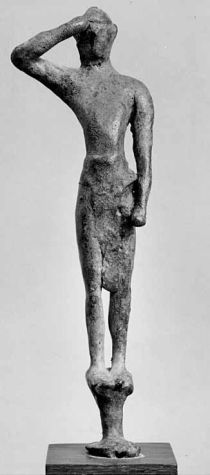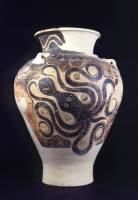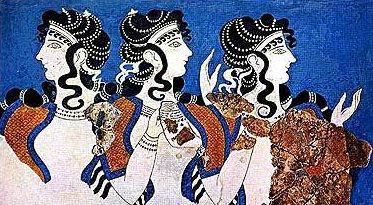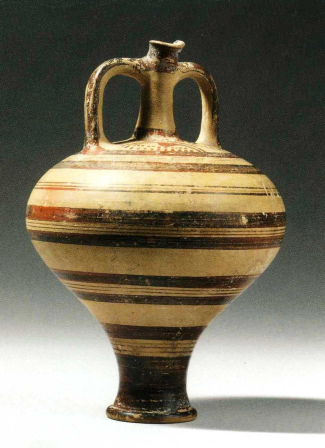Greece, Greek art in the Minoan Period (2000-1400 B.C)
In 1900, an English team of archaeologists revolutionized the study of the Mediterranean when they discovered the Palace of King Minos at Knossos, Crete. Before this Minos and his kingdom were considered mythological. In the Odyssey,
Minos was associated with Zeus. Minos prayed to Poseiden to give him a sign about whether he or someone else should rule Crete. Poseidon sent him a bull so handsome that Minos' wife fell in love with it. Minos
attempted to hide the bull but his wife found it and later had a child-half man, half bull: the Minotaur. The minotaur was hidden in the labyrinth.
A series of significant volcanic eruptions on the island of Thera probably helped to precipitate the end of Minoan civilization. Thera (also known as Santorini) probably began its eruptions in the early seventeenth
century B.C., causing a decrease in the world's temperature and altering life in the Mediterranean.

Man with elongated features, similar to Egyptian Amarna period depictiions, wearing loincloth, small Bronze statue, 18 cm., disovered in Psychro Cave, Crete, ca. 1500 B.C., Louvre, Paris

Sea creatures were a common decoration for pottery during the Minoan Period.This jar was excavated between 1900 and 1906 at the Place of Minos,
Knossos by Sir Arthur Evans. The Minoans were peace-loving and cultured. They had no walls around their seemingly idyllic kindom. Knossos probably had a population of about 80,000 at its height.

Pithos, clay storage jar, height 74.5 cm., ca. 1450 B.C.; Ashmolean Museum, Oxford, U.K.
The most significant frescoes at the Palace of Knossos were found on the first floor. They were created from 1600 to 1380 B.C. The frescoes depict a great procession; about 400 figures have been identified in it.
The image below is known as "Ladies in Blue." The head were restored during the late twentieth century by using images and tiny fragments from other frescoes.

"Ladies in Blue" East Wing of the Palace of Knossos, note the charming position of the arms, suggesting a dance.

"Spouted jar, 14th century B.C., buff-ware; 22.9 cm.
|